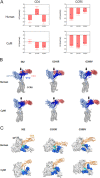Species-Specific Valid Ternary Interactions of HIV-1 Env-gp120, CD4, and CCR5 as Revealed by an Adaptive Single-Amino Acid Substitution at the V3 Loop Tip
- PMID: 33883222
- PMCID: PMC8315996
- DOI: 10.1128/JVI.02177-20
Species-Specific Valid Ternary Interactions of HIV-1 Env-gp120, CD4, and CCR5 as Revealed by an Adaptive Single-Amino Acid Substitution at the V3 Loop Tip
Abstract
Molecular interactions of the variable envelope gp120 subunit of HIV-1 with two cellular receptors are the first step of viral infection, thereby playing pivotal roles in determining viral infectivity and cell tropism. However, the underlying regulatory mechanisms for interactions under gp120 spontaneous variations largely remain unknown. Here, we show an allosteric mechanism in which a single gp120 mutation remotely controls the ternary interactions between gp120 and its receptors for the switch of viral cell tropism. Virological analyses showed that a G310R substitution at the tip of the gp120 V3 loop selectively abolished the viral replication ability in human cells, despite evoking enhancement of viral replication in macaque cells. Molecular dynamics (MD) simulations predicted that the G310R substitution at a site away from the CD4 interaction site selectively impeded the binding ability of gp120 to human CD4. Consistently, virions with the G310R substitution exhibited a reduced binding ability to human lymphocyte cells. Furthermore, the G310R substitution influenced the gp120-CCR5 interaction in a CCR5-type dependent manner as assessed by MD simulations and an infectivity assay using exogenously expressed CCR5s. Interestingly, an I198M mutation in human CCR5 restored the infectivity of the G310R virus in human cells. Finally, MD simulation predicted amino acid interplays that physically connect the V3 loop and gp120 elements for the CD4 and CCR5 interactions. Collectively, these results suggest that the V3 loop tip is a cis-allosteric regulator that remotely controls intra- and intermolecular interactions of HIV-1 gp120 for balancing ternary interactions with CD4 and CCR5. IMPORTANCE Understanding the molecular bases for viral entry into cells will lead to the elucidation of one of the major viral survival strategies, and thus to the development of new effective antiviral measures. As shown recently, HIV-1 is highly mutable and adaptable in growth-restrictive cells, such as those of macaque origin. HIV-1 initiates its infection by sequential interactions of Env-gp120 with two cell surface receptors, CD4 and CCR5. A recent epoch-making structural study has disclosed that CD4-induced conformation of gp120 is stabilized upon binding of CCR5 to the CD4-gp120 complex, whereas the biological significance of this remains totally unknown. Here, from a series of mutations found in our extensive studies, we identified a single-amino acid adaptive mutation at the V3 loop tip of Env-gp120 critical for its interaction with both CD4 and CCR5 in a host cell species-specific way. This remarkable finding could certainly provoke and accelerate studies to precisely clarify the HIV-1 entry mechanism.
Keywords: CCR5; CD4; Env-gp120; HIV-1; V3 loop; adaptive mutation; in silico structural analysis; species specificity.
Figures










Similar articles
-
Role of naturally occurring basic amino acid substitutions in the human immunodeficiency virus type 1 subtype E envelope V3 loop on viral coreceptor usage and cell tropism.J Virol. 1999 Jul;73(7):5520-6. doi: 10.1128/JVI.73.7.5520-5526.1999. J Virol. 1999. PMID: 10364300 Free PMC article.
-
HIV-1 escape from the CCR5 antagonist maraviroc associated with an altered and less-efficient mechanism of gp120-CCR5 engagement that attenuates macrophage tropism.J Virol. 2011 May;85(9):4330-42. doi: 10.1128/JVI.00106-11. Epub 2011 Feb 23. J Virol. 2011. PMID: 21345957 Free PMC article.
-
Role of V3 independent domains on a dualtropic human immunodeficiency virus type 1 (HIV-1) envelope gp120 in CCR5 coreceptor utilization and viral infectivity.Microbiol Immunol. 2001;45(7):521-30. doi: 10.1111/j.1348-0421.2001.tb02653.x. Microbiol Immunol. 2001. PMID: 11529558
-
HIV-1 envelope-receptor interactions required for macrophage infection and implications for current HIV-1 cure strategies.J Leukoc Biol. 2014 Jan;95(1):71-81. doi: 10.1189/jlb.0713368. Epub 2013 Oct 24. J Leukoc Biol. 2014. PMID: 24158961 Free PMC article. Review.
-
HIV-1 gp120 binding to dendritic cell receptors mobilize the virus to the lymph nodes, but the induced IL-4 synthesis by FcepsilonRI+ hematopoietic cells damages the adaptive immunity--a review, hypothesis, and implications.Virus Genes. 2004 Aug;29(1):147-65. doi: 10.1023/B:VIRU.0000032797.43537.d3. Virus Genes. 2004. PMID: 15215692 Review.
Cited by
-
Unique Mode of Antiviral Action of a Marine Alkaloid against Ebola Virus and SARS-CoV-2.Viruses. 2022 Apr 15;14(4):816. doi: 10.3390/v14040816. Viruses. 2022. PMID: 35458549 Free PMC article.
-
Structure-Guided Creation of an Anti-HA Stalk Antibody F11 Derivative That Neutralizes Both F11-Sensitive and -Resistant Influenza A(H1N1)pdm09 Viruses.Viruses. 2021 Aug 31;13(9):1733. doi: 10.3390/v13091733. Viruses. 2021. PMID: 34578314 Free PMC article.
-
Genetic regions affecting the replication and pathogenicity of dengue virus type 2.PLoS Negl Trop Dis. 2024 Jan 8;18(1):e0011885. doi: 10.1371/journal.pntd.0011885. eCollection 2024 Jan. PLoS Negl Trop Dis. 2024. PMID: 38190404 Free PMC article.
-
Cis-Allosteric Regulation of HIV-1 Reverse Transcriptase by Integrase.Viruses. 2022 Dec 21;15(1):31. doi: 10.3390/v15010031. Viruses. 2022. PMID: 36680070 Free PMC article.
References
-
- Freed EO, Martin MA. 2013. Human immunodeficiency viruses: replication, p 1502–1560. In Knipe DM, Howley PM (ed), Fields virology, 6th ed, vol 2. Lippincott Williams & Wilkins, Philadelphia, PA.
Publication types
MeSH terms
Substances
LinkOut - more resources
Full Text Sources
Other Literature Sources
Research Materials

